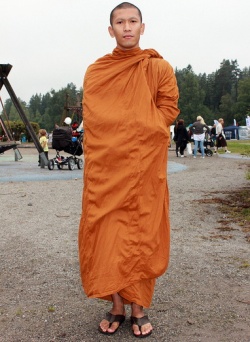Difference between revisions of "Right Concentration 2"
(Created page with " Right concentration (sammà samàdhi) is the eighth step on the Buddha’s Noble Eightfold Middle Path and is an essential component of successful m...") |
|||
| Line 1: | Line 1: | ||
| + | <nomobile>{{DisplayImages|2601|2191|1805}}</nomobile> | ||
| + | [[Right concentration]] ([[sammà samàdhi]]) is the eighth step on the [[Buddha’s]] [[Noble Eightfold Middle Path]] and is an [[essential]] component of successful [[meditation]]. | ||
| − | + | It is defined in the [[scriptures]] as ‘any [[unification of the mind]]’ ([[Majjhima Nikaya]] 1. 301) and is sometimes also called ‘[[one-pointedness of mind]]’ ([[ekodibhàva]]). | |
| − | + | The advantages of [[concentration]] are many. The [[attention]] is fixed on an [[object]] for a sustained period allowing us to come to know it better and thus it has a role to play in [[wisdom]]. | |
| − | The practice of [[vipassana meditation]] is the [[Path]] that will make the [[Middle Way]] clear, understandable, and alleviate all [[suffering]], not only for the hereafter, but right here and now in the {{Wiki|present}} [[moment]] while we are still alive. There are actually two types of [[meditation]] as [[taught]] by the [[Buddha]]. They are [[samatha]], which is the [[calm]], [[tranquil]] technique and then there is [[vipassana]], which is the type leading to [[Insight]]. Most [[meditation techniques]] in the [[Buddha’s]] time and before and even still today are primarily the [[samatha]] type. That is, they lead to a [[relaxed]] [[peaceful]] [[state]] and sometimes to great [[experiences]] of [[joy]], [[bliss]], even [[trance]], but no [[Wikipedia:Absolute (philosophy)|ultimate]] [[Insight]] of [[enlightenment]]. [[Right Concentration]] primarily deals with the [[samatha]] type of [[meditation]] which is aimed at these highly concentrative states. But [[vipassana meditation]], when done correctly, can provide the inner [[calm]] of [[samatha]] and also can lead to the [[Insight wisdom]] of [[vipassana]]. [[Concentration meditation]] techniques include many different [[meditation subjects]]. There are 40 different [[meditation subjects]] of [[samatha]] and four major techniques or foundations for [[vipassana]]. It can be direct [[one-pointedness | + | When we have developed [[concentration]] we can turn our [[attention]] to whatever we like, rather than having it constantly flitting from one thing to another as is usually the case. |
| + | |||
| + | The ability to do this can minimise useless {{Wiki|daydreaming}}, {{Wiki|worry}} and unwanted intrusive [[thoughts]] thus give us a [[degree]] of [[peace]] and [[calm]]. | ||
| + | |||
| + | In [[Buddhist meditation concentration]] is usually developed by practicing [[Mindfulness of Breathing]] ([[Majjhima Nikaya]] 3. 82). | ||
| + | |||
| + | According to the [[Buddha]] there are several things we can do which will assist in the [[development of concentration]]. The first is following the [[Precepts]]. | ||
| + | |||
| + | Doing this simplifies our [[life]] and minimizes the possibilities of [[remorse]], {{Wiki|embarrassment}} and conflicts with others, all of which keep the [[mind]] churned up. | ||
| + | |||
| + | Another thing is what the [[Buddha]] called guarding the [[sense doors]] ([[indriya samvara]]), which means not seeking out situations that will over-stimulate the [[mind]] (D.I,70). | ||
| + | |||
| + | Also, there is a direct [[connection]] between [[physical]] ease, [[psychological]] well-being and [[concentration]]. While actually [[practising meditation]], maintaining a [[relaxed]], comfortable [[posture]] will allow the [[body]] to become still without being forced. | ||
| + | |||
| + | Likewise, having a {{Wiki|light}}, [[joyful]] [[attitude]] will make [[concentration]] easier. | ||
| + | |||
| + | The [[Buddha]] said that ‘…from gladness comes [[joy]], being [[joyful]] the [[body]] is [[tranquil]], with a [[tranquil]] [[body]] one is [[happy]] and the [[mind]] that is [[happy]] becomes [[concentrated]]’ (D.I,74). | ||
| + | |||
| + | The practice of [[vipassana meditation]] is the [[Path]] that will make the [[Middle Way]] clear, understandable, and alleviate all [[suffering]], not only for the hereafter, but right here and now in the {{Wiki|present}} [[moment]] while we are still alive. | ||
| + | |||
| + | There are actually two types of [[meditation]] as [[taught]] by the [[Buddha]]. | ||
| + | |||
| + | They are [[samatha]], which is the [[calm]], [[tranquil]] technique and then there is [[vipassana]], which is the type leading to [[Insight]]. | ||
| + | |||
| + | Most [[meditation techniques]] in the [[Buddha’s]] time and before and even still today are primarily the [[samatha]] type. | ||
| + | |||
| + | That is, they lead to a [[relaxed]] [[peaceful]] [[state]] and sometimes to great [[experiences]] of [[joy]], [[bliss]], even [[trance]], but no [[Wikipedia:Absolute (philosophy)|ultimate]] [[Insight]] of [[enlightenment]]. | ||
| + | |||
| + | [[Right Concentration]] primarily deals with the [[samatha]] type of [[meditation]] which is aimed at these highly concentrative states. | ||
| + | |||
| + | But [[vipassana meditation]], when done correctly, can provide the inner [[calm]] of [[samatha]] and also can lead to the [[Insight wisdom]] of [[vipassana]]. | ||
| + | |||
| + | [[Concentration meditation]] techniques include many different [[meditation subjects]]. There are 40 different [[meditation subjects]] of [[samatha]] and four major techniques or foundations for [[vipassana]]. | ||
| + | |||
| + | It can be direct [[one-pointedness concentration]] on a devotional figure such as a statue of [[Buddha]], {{Wiki|Jesus}}, or Mary. | ||
| + | |||
| + | |||
| + | The common [[subject]] for beginners is [[awareness of breath]]. | ||
| + | |||
| + | |||
| + | The [[meditator]] remains in the {{Wiki|present}} [[moment]] focusing on the in and out [[breath]] of the [[body]]. The [[mind and body]] become [[calm]] and free of negative [[thoughts]]. | ||
{{R}} | {{R}} | ||
http://www.dhammawiki.com/index.php?title=Right_Concentration | http://www.dhammawiki.com/index.php?title=Right_Concentration | ||
[[Category:Concentration]] | [[Category:Concentration]] | ||
Revision as of 02:10, 11 March 2016
Right concentration (sammà samàdhi) is the eighth step on the Buddha’s Noble Eightfold Middle Path and is an essential component of successful meditation.
It is defined in the scriptures as ‘any unification of the mind’ (Majjhima Nikaya 1. 301) and is sometimes also called ‘one-pointedness of mind’ (ekodibhàva).
The advantages of concentration are many. The attention is fixed on an object for a sustained period allowing us to come to know it better and thus it has a role to play in wisdom.
When we have developed concentration we can turn our attention to whatever we like, rather than having it constantly flitting from one thing to another as is usually the case.
The ability to do this can minimise useless daydreaming, worry and unwanted intrusive thoughts thus give us a degree of peace and calm.
In Buddhist meditation concentration is usually developed by practicing Mindfulness of Breathing (Majjhima Nikaya 3. 82).
According to the Buddha there are several things we can do which will assist in the development of concentration. The first is following the Precepts.
Doing this simplifies our life and minimizes the possibilities of remorse, embarrassment and conflicts with others, all of which keep the mind churned up.
Another thing is what the Buddha called guarding the sense doors (indriya samvara), which means not seeking out situations that will over-stimulate the mind (D.I,70).
Also, there is a direct connection between physical ease, psychological well-being and concentration. While actually practising meditation, maintaining a relaxed, comfortable posture will allow the body to become still without being forced.
Likewise, having a light, joyful attitude will make concentration easier.
The Buddha said that ‘…from gladness comes joy, being joyful the body is tranquil, with a tranquil body one is happy and the mind that is happy becomes concentrated’ (D.I,74).
The practice of vipassana meditation is the Path that will make the Middle Way clear, understandable, and alleviate all suffering, not only for the hereafter, but right here and now in the present moment while we are still alive.
There are actually two types of meditation as taught by the Buddha.
They are samatha, which is the calm, tranquil technique and then there is vipassana, which is the type leading to Insight.
Most meditation techniques in the Buddha’s time and before and even still today are primarily the samatha type.
That is, they lead to a relaxed peaceful state and sometimes to great experiences of joy, bliss, even trance, but no ultimate Insight of enlightenment.
Right Concentration primarily deals with the samatha type of meditation which is aimed at these highly concentrative states.
But vipassana meditation, when done correctly, can provide the inner calm of samatha and also can lead to the Insight wisdom of vipassana.
Concentration meditation techniques include many different meditation subjects. There are 40 different meditation subjects of samatha and four major techniques or foundations for vipassana.
It can be direct one-pointedness concentration on a devotional figure such as a statue of Buddha, Jesus, or Mary.
The common subject for beginners is awareness of breath.
The meditator remains in the present moment focusing on the in and out breath of the body. The mind and body become calm and free of negative thoughts.
Source
http://www.dhammawiki.com/index.php?title=Right_Concentration


